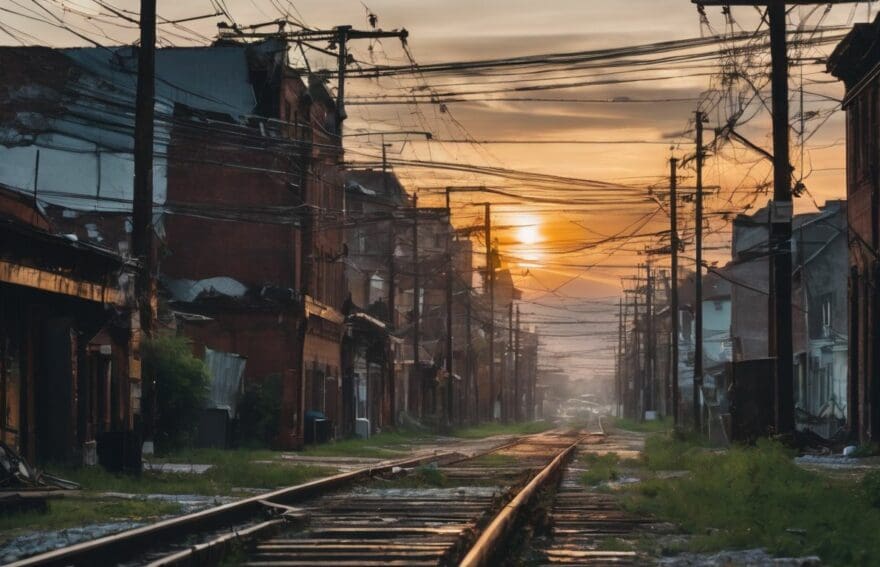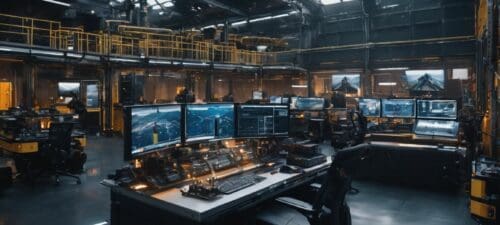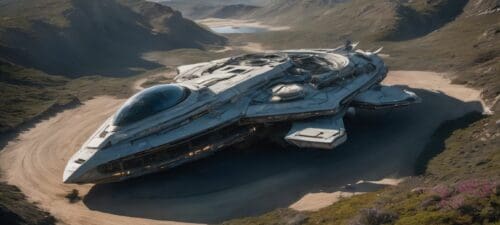Death Stranding: Connections in a Fragmented World

Updated On: November 03, 2025 by 
In an era where technology intertwines our lives like never before, it’s curious how a sense of solitude can still wash over us. Even amidst the constant buzz of our digital cocoons, that nagging sense of being adrift in a sea of connectedness persists.
‘Death Stranding’ is not merely another title to add to your gaming collection – rather, it reflects this very paradox with its narrative centred on restoring severed ties across a fragmented realm.
Delve into the game’s world and you may well find parallels with overcoming the loneliness that pervades modern life. Come along on an unanticipated odyssey as we explore how cultivating connections within this virtual landscape might shed light on healing divisions in the tangible world around us.
The Setting of Death Stranding
In Death Stranding, the setting is a fragmented society living in bunkers, where the protagonist, Sam Porter Bridges, plays a crucial role in reconnecting communities. The necessity to rebuild infrastructure and reconnect the world through the Chiral Network drives the narrative forward.
A fragmented society living in bunkers
In Death Stranding, we step into a world where everyone hides in bunkers, disconnected and isolated. The game paints a bleak picture of the future, showing us cities turned into Knot Cities – solitary points in this shattered society.
As part of BRIDGES, our mission is to knit these secluded refuges together using the Chiral Network.
We traverse across desolate landscapes to reach scientists like paleontologists and enigmatic characters such as preppers and the Collector. Each delivery we make forges a link that could revive the dying embers of social dynamics and infrastructure amidst crisis and survival.
It’s more than just gameplay; it’s about rebuilding hope in an apocalyptic world through connectivity and altruism.
The role of the protagonist, Sam Porter Bridges
Sam Porter Bridges plays a pivotal role as the protagonist in Death Stranding, tasked with bringing together disconnected societies by connecting them to the Chiral Network. As part of BRIDGES, players embody this deliveryman, striving to unite fragmented communities and restore hope in a world devastated by cataclysms.
Sam’s character symbolises resilience and determination as he navigates through desolation, reinforcing the game’s theme of human connectivity and unity. Through his journey, players experience the profound impact of building bridges between isolated cities and individuals, emphasising the significance of forming connections within a shattered society.
Moving on to “The Importance of Connectivity”..
The necessity to reconnect the world through the Chiral Network
Transitioning from the role of the protagonist, Sam Porter Bridges, we see the necessity to reconnect the world through the Chiral Network. This critical task falls on players as they step into Sam’s shoes.
The Chiral Network serves as a lifeline for isolated communities, providing essential resources and communication channels between disconnected nodes in this fragmented society. By expanding this network, players can facilitate collaborations that strengthen these newfound connections and ultimately contribute to rebuilding a fractured world.
Hideo Kojima’s vision emphasises how connectivity shapes not only gameplay but also themes of unity and hope within Death Stranding’s narrative. As members of BRIDGES, players are tasked with unravelling the potential of infrastructure and connection while simultaneously grappling with existential questions about life and death amidst a post-apocalyptic landscape.
The Importance of Connectivity
The importance of connectivity in Death Stranding cannot be overstated. It plays a crucial role in connecting isolated communities, strengthening new connections, and significantly impacts the gameplay experience.
Connecting isolated communities
Players in Death Stranding are tasked with the pivotal mission of connecting isolated communities dispersed in a fragmented world. By bringing these disconnected entities together through the Chiral Network, they can bridge communication gaps and fortify new connections.
This action not only influences the gameplay but also highlights the significance of unity within a fractured society struggling to find hope in a post-apocalyptic world.
Furthermore, players have the opportunity to connect all facilities, locate paleontologists, cities, and hidden preppers within the game. Additionally, they face challenges such as finding ways to reach characters like “the Collector,” underscoring the game’s emphasis on facilitating connections and overcoming obstacles for societal growth and reconstruction.
Strengthening the new connections
After connecting isolated communities, the next step in Death Stranding involves strengthening these new connections. As members of BRIDGES, players are tasked with expanding and enhancing the Chiral Network to increase connectivity between bunkers and cities.
This expansion is pivotal in unifying fragmented societies and fostering a sense of unity in the post-apocalyptic world. Strengthening these connections not only benefits gameplay by unlocking new locations and resources but also contributes to the overarching theme of rebuilding a fractured society through interconnectivity.
As players progress through the game, they encounter various challenges that test their ability to strengthen these newfound bonds. From delivering essential supplies to remote outposts to establishing efficient transportation routes, every action taken serves to reinforce the vital connections within Death Stranding’s world.
The impact on the gameplay
The Chiral Network connectivity in Death Stranding significantly influences the gameplay. By connecting isolated communities and expanding the network, players unlock new features that aid in their journey.
This includes accessing shared structures built by other players, receiving valuable tips, and even borrowing equipment left behind by fellow travelers. The multiplayer feature allows for collaboration with others through a collective effort to rebuild society amidst fragmented isolation.
Moreover, these connections not only impact individual gameplay but also contribute to enhancing the experience for all players involved. This interconnectedness brings depth to the game’s narrative, creating a sense of unity and solidarity as everyone works towards a common goal.
The seamless integration of multiplayer elements into the storyline adds an extra layer of immersion and excitement for those navigating through this post-apocalyptic world.
The Artistic Journey of Death Stranding
Experience the stunning post-apocalyptic landscapes, thought-provoking themes of life and death, and a reflection on society and human connections in Death Stranding. Dive into our blog to discover more about the artistic journey behind this captivating game.
The use of post-apocalyptic landscapes
The game’s post-apocalyptic landscapes serve as a hauntingly beautiful backdrop, merging the remnants of human civilisation with nature’s reclamation. As players traverse these desolate terrains, they encounter abandoned cities, ruined infrastructure, and surreal geological formations that create an eerie yet captivating environment.
The game’s depiction of post-apocalyptic landscapes prompts contemplation on the fragility of human existence and the resilience of nature in the face of devastation.
Death Stranding uses its post-apocalyptic setting to convey themes of isolation, survival, and hope amidst despair. The barren landscapes become a visual metaphor for humanity’s struggle to rebuild amidst chaos and destruction – an experience that resonates deeply within players as they navigate through these evocative environments.
Themes of life and death
Transitioning from the post-apocalyptic landscapes, Death Stranding delves into deep themes of life and death. The game presents a thought-provoking exploration of human existence in a fragmented world.
As players navigate through the post-apocalyptic setting, they are confronted with profound questions about mortality and the human experience. The blurring of boundaries between life and death invites contemplation on the fragility and resilience of humanity, adding an immersive layer to the game’s storytelling.
Reflecting on society’s struggle for unity and hope in a post-apocalyptic world, Death Stranding offers a philosophical perspective on life and death. It prompts players to ponder over these existential themes while navigating through its intricate narrative, making them contemplate their own perceptions of mortality within the context of the game’s fragmented reality.
Reflection on society and human connections
Transitioning from the contemplation of life and death, Death Stranding invites us to reflect on society and human connections within a fragmented world. The game beautifully portrays how isolated communities can be brought together through connectivity, emphasising the significance of building infrastructure and fostering unity in a post-apocalyptic setting.
This philosophical exploration by Hideo Kojima prompts players to consider the importance of connection, crisis, and hope in shaping a fragile society struggling for cohesion amidst adversity.
Delving into Death Stranding’s narrative evokes an appreciation for the profound impact of forging meaningful relationships in a fractured world. The game’s artistic portrayal not only captures the essence of human resilience but also serves as a poignant reflection on our own societal dynamics, prompting introspection on the parallels between virtual connections and those we foster in reality.
Multiplayer Features
– Revealing the concept of multiplayer in Death Stranding allows for a unique experience where players can interact and collaborate with each other in the game world. This adds a new layer to the narrative and gameplay, emphasising the importance of human connections even in a digital landscape.
Revealing the concept of multiplayer
In Death Stranding, the concept of multiplayer introduces a unique element to the game. Players can leave behind helpful items and structures in their world, which can be discovered and utilised by other players.
This collaborative approach allows for the sharing of resources and assistance among users, creating a sense of community within the fragmented world of Death Stranding.
As part of the multiplayer experience, players are also able to see traces of other gamers’ actions within their own gameplay, fostering a feeling of interconnectedness despite the isolated setting.
The role of other players in the game
Having understood the concept of multiplayer in Death Stranding, it’s essential to acknowledge the impactful role that other players play within the game. As members of the BRIDGES community, individual players contribute to a collective effort by leaving behind helpful structures and resources for fellow travellers in their respective gameplay sessions.
This collaboration not only fosters a sense of camaraderie among players but also reinforces the theme of interconnectedness prevalent throughout the game. Additionally, encountering structures and items left behind by other players can significantly aid one’s progression through challenging landscapes and serve as a constant reminder of humanity’s ability to support and lift each other up in times of adversity.
Embracing this unique feature enriches the gaming experience by intertwining personal narratives with those of other players seamlessly. Individuals are therefore encouraged to act selflessly for mutual benefit, reinforcing themes such as empathy and cooperation present within Death Stranding’s narrative.
The impact on the narrative and gameplay
Connecting with other players in Death Stranding not only enhances the narrative but also influences the gameplay. The experiences and contributions of other players affect the world within the game, creating a dynamic and interconnected environment.
This shared connection impacts the storytelling, making it more immersive and engaging for both experienced gamers and novices.
As players collaborate to build bridges, structures, and share resources to aid each other’s progress, they actively contribute to shaping their individual storylines. This interactivity elevates the overall gaming experience as it emphasises unity and collaboration in a fragmented world.
Conclusion and Reflection on Death Stranding
The significance of connecting in a fragmented world is beautifully portrayed in Death Stranding, as players are immersed in the beauty of connectivity through the game’s storytelling.
The impact of Death Stranding on players’ perceptions of isolation in the real world is profound, offering a reflection on society and human connections that goes beyond the virtual realm.
The significance of connecting in a fragmented world
Connecting in a fragmented world is at the core of Death Stranding, as players embark on a mission to bridge isolated communities and rebuild a shattered society. Through the Chiral Network, the game emphasises the importance of establishing connections to strengthen new alliances and pave the way for progress.
These connections not only impact gameplay but also serve as an artistic reflection on themes such as life, death, and human resilience within a post-apocalyptic landscape.
Players witness the significance of connectivity through their interactions with various characters like Sam Porter Bridges and The Collector. As they navigate through this broken world, they learn that creating meaningful connections can transcend isolation and reshape fragmented societies into unified entities striving for survival and growth.
The beauty of connectivity in the game’s storytelling
Connecting the various isolated communities in Death Stranding isn’t just a gameplay mechanic – it’s an integral part of the game’s storytelling. As players, we are not just building structures and delivering supplies; we are actively participating in rebuilding society.
The beauty of this lies in how our actions directly impact the world around us, creating a narrative that is shaped by our choices and connections.
We witness the impact of our efforts as previously isolated communities begin to thrive once they are brought into the Chiral Network. It’s not just about completing tasks, but rather about seeing the tangible results of our connectivity efforts reflected in the game world.
The impact of Death Stranding on players’ perceptions of isolation in the real world.
Death Stranding prompts players to reevaluate their perceptions of isolation, as they actively engage in connecting fragmented communities within the game. By linking these disconnected nodes through the Chiral Network, players experience firsthand the significance of human connection in overcoming social isolation.
The game’s emphasis on forging bonds and rebuilding society in a post-apocalyptic world leaves a lasting impression, challenging players to consider the impact of connectivity on their own real-world experiences.
Playing Death Stranding gives gamers a tangible understanding of how connections can combat feelings of fragmentation and disconnect. As they navigate the game’s openworld setting and interact with its characters, players gain insights into the value of social infrastructure and unity amidst adversity – themes that resonate deeply with real-life challenges related to isolation and disconnection.
FAQs
1. What is ‘Death Stranding: Connections in a Fragmented World’ about?
‘Death Stranding: Connections in a Fragmented World’ is a video game set in a post-apocalyptic environment where players work to rebuild society by creating connections across vast landscapes.
2. How does the game’s post-apocalyptic setting affect gameplay?
In this unique game world, the post-apocalyptic setting challenges players with harsh environments and disconnected societies that they must navigate and reconnect for survival.
3. What makes ‘Death Stranding’ different from other video games?
‘Death Stranding’ stands out due to its focus on connection rather than combat, requiring players to bridge gaps between isolated communities in an otherwise fragmented world.
4. Can you interact with other players in ‘Death Stranding’?
Yes, while traversing the fragmented world of ‘Death Stranding’, you can encounter structures or items left by other players, emphasising connectivity even as each player embarks on their own solitary journey.









